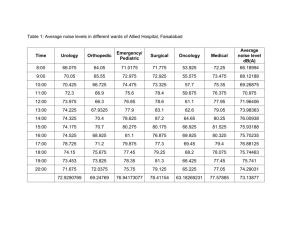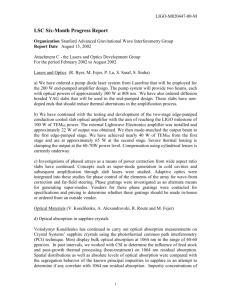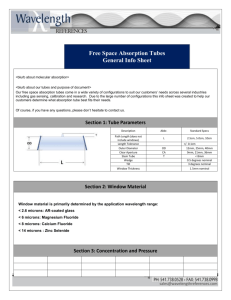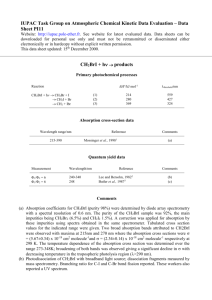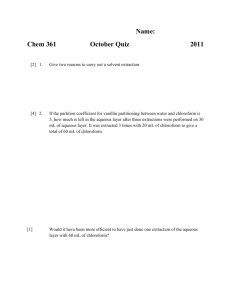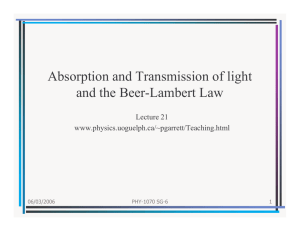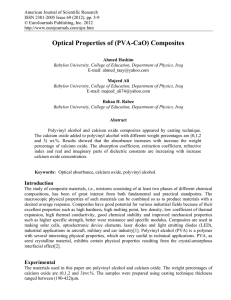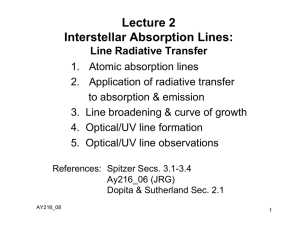finally construct
advertisement
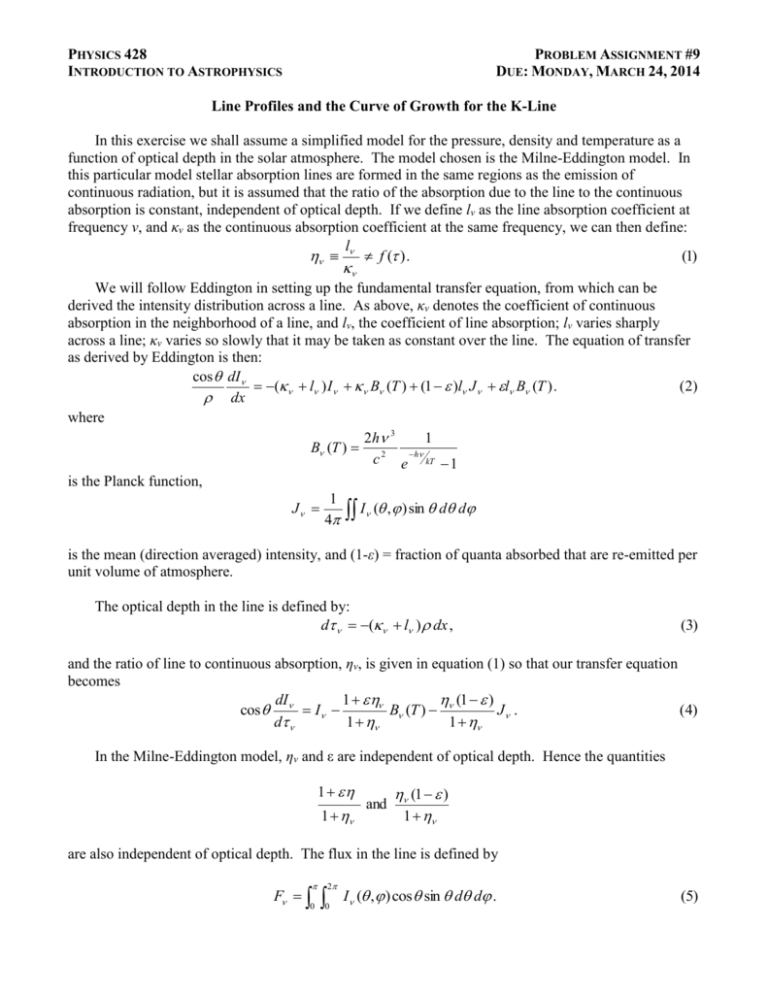
PHYSICS 428 INTRODUCTION TO ASTROPHYSICS PROBLEM ASSIGNMENT #9 DUE: MONDAY, MARCH 24, 2014 Line Profiles and the Curve of Growth for the K-Line In this exercise we shall assume a simplified model for the pressure, density and temperature as a function of optical depth in the solar atmosphere. The model chosen is the Milne-Eddington model. In this particular model stellar absorption lines are formed in the same regions as the emission of continuous radiation, but it is assumed that the ratio of the absorption due to the line to the continuous absorption is constant, independent of optical depth. If we define lν as the line absorption coefficient at frequency ν, and κν as the continuous absorption coefficient at the same frequency, we can then define: l f ( ) . (1) We will follow Eddington in setting up the fundamental transfer equation, from which can be derived the intensity distribution across a line. As above, κν denotes the coefficient of continuous absorption in the neighborhood of a line, and lν, the coefficient of line absorption; lν varies sharply across a line; κν varies so slowly that it may be taken as constant over the line. The equation of transfer as derived by Eddington is then: cos dI ( l ) I B (T ) (1 )l J l B (T ) . (2) dx where 2h 3 1 B (T ) 2 h c e kT 1 is the Planck function, 1 J I ( , ) sin d d 4 is the mean (direction averaged) intensity, and (1-ε) = fraction of quanta absorbed that are re-emitted per unit volume of atmosphere. The optical depth in the line is defined by: d ( l ) dx , (3) and the ratio of line to continuous absorption, ην, is given in equation (1) so that our transfer equation becomes dI 1 (1 ) cos I B (T ) J . (4) d 1 1 In the Milne-Eddington model, ην and ε are independent of optical depth. Hence the quantities 1 1 and (1 ) 1 are also independent of optical depth. The flux in the line is defined by F 0 2 0 I ( , ) cos sin d d . (5) Defining the residual intensity in the line, rν, as the ratio of flux in the line to the flux in the continum, the solution of equation (4) is X 0 1 2 2 q 1 3 4 n (1 ) 3 3 r . 2 1 X 0 2 1 q 3 3 4 n 3 Here X 0 h kT 1 h kT and n , (6) (7a, 7b) 1 e where mean absorption coefficient taken at mean optical depth, and 1 q2 3 . 1 In our problem, we shall assume that n 1, and 0.05 , so that (8) 3X 0 8(1 ) 8.61880 r . (9) 3 X 0 4.61880 q 2 We shall consider the K-line of ionized calcium (Ca II), λ3933. The first factor in equation (9) varies only slightly in the third significant figure, hence errors will not exceed one percent by computing this quantity for the line center and using that value over the entire line. On the attached data sheet is given the line absorption coefficient, expressed as ην/N, where N = number of atoms of Ca II per gram of solar material, given as a function of Δλ in Angstroms from the line center. We have assumed symmetry; in practice the absorption coefficient is nearly so. q Procedure Compute the residual intensities and the profile of the CaII K-line, for N = 1011, 1013 and 1016 atoms/gram. Plot the profiles, on large enough scale so that their equivalent widths may be measured (or do appropriate numerical integrations to get the Ws). Finally, construct a theoretical curve or growth for Ca II in the sun, plotting logW versus logN, using your three measured values and the supplementary values given on the data sheet. Then discuss these questions: 1. What are the slopes of the three sections of the curve of growth (i.e., find n in: W N n for each of the three sections). 2. How are the line profiles different in the three sections? Can you suggest the physical mechanisms behind this? DATA SHEET (Ca II K line) 3933.666 A , hc 25242.7 kT [ A] T 5700 K , LINE ABSORPTION COEFFICIENT Δλ [] ην /N Δλ [] ην /N 0.000 6.5499 × 10-12 0.162 1.7468 × 10-15 0.004 6.3011 × 10-12 0.202 1.1077 × 10-15 0.008 5.6105 × 10-12 0.242 7.6554 × 10-16 0.012 4.6253 × 10-12 0.300 4.9814 × 10-16 0.016 3.5327 × 10-12 0.400 2.8021 × 10-16 0.020 2.5025 × 10-12 0.600 1.2454 × 10-16 0.030 7.7292 × 10-13 1.000 4.4833 × 10-17 0.040 1.6797 × 10-13 1.500 1.9926 × 10-17 0.050 3.8117 × 10-14 2.000 1.1208 × 10-17 0.061 1.6016 × 10-14 3.000 4.9814 × 10-18 0.081 7.5918 × 10-15 5.000 1.7933 × 10-18 0.101 4.6575 × 10-15 10.000 4.4833 × 10-19 0.121 3.1670 × 10-15 EQUIVALENT WIDTHS OF K-LINE log10 N [atoms/gram] log10 W [] 10 -2.9191 12 -1.4605 14 -0.8368 15 -0.3840 17 +0.6112 18 +1.0993

